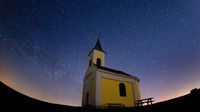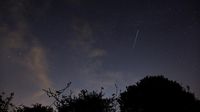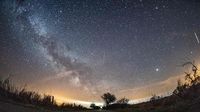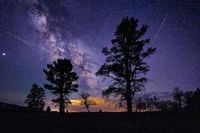The first meteor shower of the year is here, with the Lyrids peaking late tonight into the pre-dawn hours on Tuesday. Here’s what you need to know to catch the show.
The Lyrid meteor shower will be active through Friday, April 25, 2025, but peak viewing is tonight, April 21, 2025, starting around midnight. Under dark skies, the best time to catch the meteors would be 3 a.m. to 4 a.m. on Tuesday, April 22, 2025. However, the moon will be rising and obscuring the dimmer Lyrids. Experts recommend finding an object, such as a tree, to block the moon, keeping the moon at your back, or heading out while the moon is low on the horizon.
The meteors will radiate from the constellation Lyra. The Adler Planetarium recommends looking for the bright star Vega to find Lyra, which will rise higher in the night sky the closer it gets to dawn. Because meteors radiate, they can appear in all parts of the sky. Just have patience and look up, allowing a half hour or so for your eyes to adjust to the dark—this means putting away your phone and other sources of extraneous light.
While the Lyrids aren’t as prolific as some other meteor showers, producing 10-15 bursts an hour, they are also famous for uncommon surges of 100 meteors per hour, according to EarlySky. Some Lyrids can leave bright trails that last for seconds. Every April, Earth passes through a stream of debris generated by Comet Thatcher. According to NASA, bits of this debris “collide with our atmosphere where they disintegrate to create fiery and colorful streaks in the sky.”
The Lyrids have been observed for nearly 3,000 years, but their source—Comet Thatcher—wasn’t discovered until 1861. The Lyrid meteor showers in the northern hemisphere are forecasted to reach peak activity tonight and tomorrow. The best viewing times are after moonset and before dawn, and the less light pollution, the better.
The active period is from April 17 through April 26, with peak activity on April 21-22, according to the 2025 meteor calendar. When looking up this week, NASA added that the radiant, or point in the sky where the Lyrids appear to come from, is near the constellation Lyra, the harp. Constellation Lyra includes the stars Vega, Sheliac, and Sulafat.
With many years of sighted documentation, the Lyrids are the oldest continuously recorded meteor shower, dating back to 687 BC. While records of the meteor showers date back 2,700 years, NASA said that the pieces of space debris interact with the atmosphere to create the Lyrids, which originate from comet C/1861 G1 Thatcher, also known as Comet Thatcher, discovered by A. E. Thatcher on April 5, 1861.
The Lyrid meteor showers are known for fast and bright meteors. However, the April meteor shower is not always plentiful; it is known to surprise skywatchers on an annual occasion with heavy showers, with as many as 100 meteors seen per hour. “The Lyrids are a medium strength shower that usually produces good rates for three nights centered on the maximum,” states the American Meteor Society.
Additionally, while the April meteor showers usually lack persistent trains, they are known for producing fireballs. The meteors will peak in activity between Monday, April 21, 2025, and Tuesday, April 22, 2025, as Earth passes through the densest part of Thatcher's cosmic debris. After that, the activity will begin to slow down and stop altogether by Saturday, April 26, according to the American Meteor Society.
Cloud and storms may interfere with the view of the Lyrid meteor shower for some observers this year, according to AccuWeather. A storm will move across the eastern half of North America during the peak shower activity, spreading clouds across most of the East Coast. Another storm is expected to bring cloudy conditions through much of the north-central U.S., AccuWeather said. This makes the West Coast and Southwest U.S., including central Texas, the best place to witness the Lyrids this year. A pocket of the Midwest, including areas west and south of Chicago, should also have good views, according to AccuWeather.
Seasoned stargazers should easily be able to find Vega in the night sky, but if you need help locating it, look above the horizon toward the northeast between 7 and 8 p.m. MT or about 9 to 10 p.m. ET. Getting away from city light pollution and street lights will also help to unveil the best sights.
During the peak, 10-20 Lyrid meteors can be seen per hour. Lyrids don’t tend to leave long glowing dust trains behind them as they streak through the Earth's atmosphere, but they can produce the occasional bright flash called a fireball. Meteor showers occur when Earth passes through the debris left by comets and other space objects as they orbit the sun. The debris—space rocks known as meteoroids—collide with Earth's atmosphere at high speed and disintegrate, creating fiery and colorful streaks in the sky, according to NASA. Those resulting fireballs, better known as "shooting stars," are meteors. If meteoroids survive their trip to Earth without burning up in the atmosphere, they are called meteorites, according to NASA.




